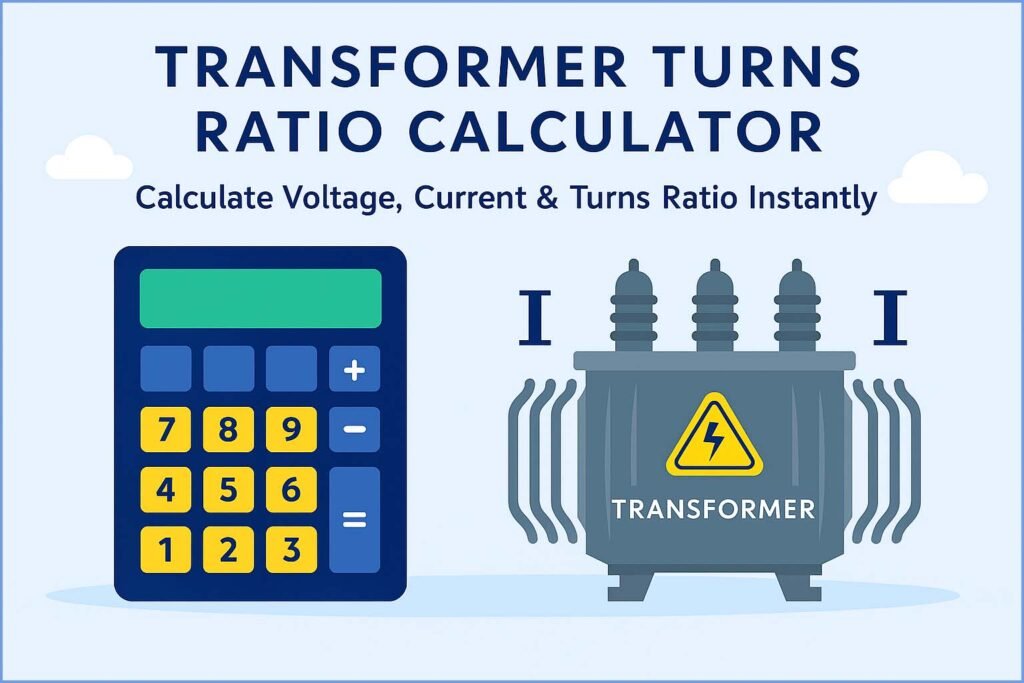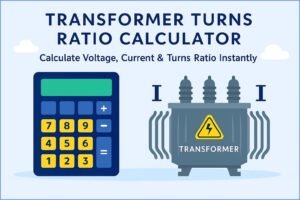Transformer Turns Ratio Calculator – Calculate Voltage, Current & Turns Ratio Instantly
A Transformer Turns Ratio Calculator is one of the most useful tools for electrical engineers, technicians, and students who work with power transformers. It helps calculate the relationship between the primary and secondary windings of a transformer, allowing you to predict voltage, current, and impedance levels with high accuracy. Understanding the turns ratio is essential in designing, testing, and troubleshooting transformers in both power and electronic systems.

Table of Contents
What Is a Transformer Turns Ratio Calculator
A Transformer Turns Ratio Calculator is a simple yet powerful tool that determines the ratio between the number of turns in the primary coil and the number of turns in the secondary coil of a transformer.
This ratio defines how voltage and current are transferred between the two sides. When the number of turns on each coil is known, or when the input and output voltages are available, the calculator helps find the turns ratio instantly.
Transformer Turns Ratio Calculator
Transformer Turns Ratio Calculator
Calculate voltage and winding turns ratio for single-phase or three-phase transformers. Supports both voltage-based and coil-based inputs.
In electrical design, knowing the turns ratio is critical because it directly affects how much the voltage increases or decreases between the primary and secondary sides. For example, if a transformer has a turns ratio of 10:1, it means the primary winding has ten times more turns than the secondary winding. In this case, the voltage will be stepped down by a factor of ten, while the current will increase by the same factor.
Use our online tool Transformer Capacity Calculation Tool – Accurate Load and Power Sizing for Electrical Systems
How the Transformer Turns Ratio Works
The operation of a transformer depends on electromagnetic induction. When alternating current (AC) flows through the primary winding, it creates a magnetic flux in the core. This flux induces a voltage in the secondary winding according to the ratio of the turns in both coils. The relationship can be expressed as:
| Formula | Description |
|---|---|
| Vp / Vs = Np / Ns | Vp = Primary Voltage, Vs = Secondary Voltage, Np = Primary Turns, Ns = Secondary Turns |
| Ip / Is = Ns / Np | Ip = Primary Current, Is = Secondary Current |
From these formulas, we can understand that if the primary coil has more turns than the secondary, the voltage will decrease on the secondary side (step-down transformer). If the secondary has more turns, the voltage will increase (step-up transformer).
Why Use a Transformer Turns Ratio Calculator
Manual calculations can be time-consuming and prone to error, especially when testing multiple transformers. A Transformer Turns Ratio Calculator simplifies this process by instantly giving accurate results. Whether you are testing power transformers, audio transformers, or small PCB-mounted devices, this tool ensures you get precise voltage and turns ratio information within seconds.
Here are a few key benefits of using this calculator:
- Saves time during transformer testing or design
- Reduces calculation errors
- Ideal for both step-up and step-down transformer analysis
- Helps confirm proper transformer performance
- Useful in troubleshooting faulty or mismatched windings
Use our online tool Automatic Transformer Rating Calculator – Find the Right Transformer Capacity for Your Load
Transformer Turns Ratio Formula
The basic formula used in the Transformer Turns Ratio Calculator is simple yet powerful:
Turns Ratio (TR) = Np / Ns = Vp / Vs
Where:
- Np = Number of turns on the primary winding
- Ns = Number of turns on the secondary winding
- Vp = Primary voltage
- Vs = Secondary voltage
For instance, if a transformer has a primary voltage of 230V and a secondary voltage of 23V, then:
Turns Ratio = 230 / 23 = 10:1
This means the transformer reduces the voltage by a factor of ten.
| Parameter | Symbol | Example Value | Unit |
|---|---|---|---|
| Primary Voltage | Vp | 230 | Volts |
| Secondary Voltage | Vs | 23 | Volts |
| Turns Ratio | TR | 10:1 | — |
The calculator applies this same principle automatically, allowing you to enter any two values and instantly find the third.
How to Use the Transformer Turns Ratio Calculator
Using the Transformer Turns Ratio Calculator is extremely simple. You only need to input known values, and the tool will calculate the unknown instantly.
- Enter the primary voltage and secondary voltage if you want to find the turns ratio.
- If you know the turns on both windings, enter those values to calculate the voltage ratio.
- The calculator will display the turns ratio in standard format (e.g., 10:1).
- You can also use the calculator to find unknown voltages if the turns ratio is known.
This flexibility makes it valuable for laboratory tests, transformer maintenance, and academic use.
Use our online tool Transformer Sizing Chart Calculator – Calculate the Right Transformer Size for Your Load
Understanding Step-Up and Step-Down Transformers
To get the best results from the Transformer Turns Ratio Calculator, it is important to understand the two main types of transformers:
| Type | Turns Ratio | Voltage Output | Application |
|---|---|---|---|
| Step-Up Transformer | Ns > Np | Vs > Vp | Power generation, transmission |
| Step-Down Transformer | Np > Ns | Vs < Vp | Power distribution, electronics |
A step-up transformer increases voltage and decreases current, while a step down transformer reduces voltage and increases current. The calculator helps confirm that the designed transformer performs exactly as intended by comparing calculated values with expected results.
Real-Life Applications of Transformer Turns Ratio
The Transformer Turns Ratio Calculator is used in many industries and applications where transformers are a core component. Some key examples include:
- Power distribution networks for step-up and step-down voltage transformation
- Electrical engineering laboratories for transformer testing and learning
- Industrial control panels and automation systems
- Audio systems where impedance matching is essential
- Renewable energy systems like solar inverters and battery chargers
By understanding the turns ratio, engineers can ensure safe operation, prevent overvoltage damage, and maintain efficiency in electrical systems.
Example Calculation Using Transformer Turns Ratio Calculator
Let’s consider an example to understand how this calculator works in practice.
Example:
A transformer has a primary voltage of 440V and secondary voltage of 110V.
Solution:
Turns Ratio = Vp / Vs = 440 / 110 = 4:1
This means the transformer steps down voltage from 440 volts to 110 volts. The same result can be obtained instantly using the Transformer Turns Ratio Calculator.
Now, if the transformer primary winding has 800 turns, then the secondary winding should have:
Ns = Np / Turns Ratio = 800 / 4 = 200 turns
This shows the proportional relationship between the number of turns and voltage levels.
| Calculation Step | Formula | Result |
|---|---|---|
| Voltage Ratio | 440 / 110 | 4:1 |
| Secondary Turns | 800 / 4 | 200 turns |
Use our online tool Transformer Inrush Current Calculator – Accurate Tool for Power System Engineers
Transformer Efficiency and Turns Ratio
The turns ratio also influences transformer efficiency and voltage regulation. If the turns ratio is not accurate, the transformer may produce incorrect output voltage, leading to power loss or overheating.
While the calculator gives an ideal value, in real-world scenarios, small variations occur due to winding resistance, core losses, and leakage flux. By comparing calculated values with measured results, you can assess transformer health and detect issues early.
Importance of Using a Digital Calculator for Turns Ratio
Manually computing turns ratio can lead to errors in decimal placement or ratio simplification. The Transformer Turns Ratio Calculator eliminates such errors, ensuring accurate results for testing and design. It also allows engineers to analyze multiple transformers quickly without manual repetition.
For manufacturing and quality assurance teams, the calculator is essential for verifying transformer consistency and confirming compliance with design specifications.
Use our online tool Single Phase Transformer Calculator – Accurate Transformer Sizing & Efficiency Tool
Conclusion
The Transformer Turns Ratio Calculator is a practical and efficient tool for every electrical engineer and technician involved in transformer design, testing, and troubleshooting. By simply entering the primary and secondary voltage or turns, you can instantly find the turns ratio, voltage ratio, or current ratio.
Whether you’re testing a small audio transformer or a high-voltage power transformer, this calculator saves time and improves accuracy. It also helps students and professionals understand transformer behavior and relationships more clearly.
In short, this tool bridges theory and practical application, ensuring every transformer performs exactly as designed. Try the Transformer Turns Ratio Calculator now to simplify your analysis and achieve precise, reliable results in seconds.
Follow Us on Social:
Subscribe our Newsletter on Electrical Insights to get the latest updates in Electrical Engineering.
#TransformerTurnsRatioCalculator, #TransformerCalculator, #ElectricalEngineering, #PowerTransformer, #VoltageRatio, #CurrentRatio, #TurnsRatioFormula, #TransformerDesign, #TransformerTesting, #ElectricalTools, #EngineeringCalculator, #CircuitDesign, #TransformerEfficiency, #ElectronicsProjects, #EnergyConversion
Transformer Turns Ratio Calculator – Calculate Voltage, Current & Turns Ratio Instantly : Electrical Engineering Hub

A Transformer Turns Ratio Calculator is one of the most useful tools for electrical engineers, technicians, and students who work with power transformers. It helps calculate the relationship between the primary and secondary windings of a transformer, allowing you to predict voltage, current, and impedance levels with high accuracy. Understanding the turns ratio is essential in designing, testing, and troubleshooting transformers in both power and electronic systems.
Price Currency: USD
Operating System: All
Application Category: UtilitiesApplication
